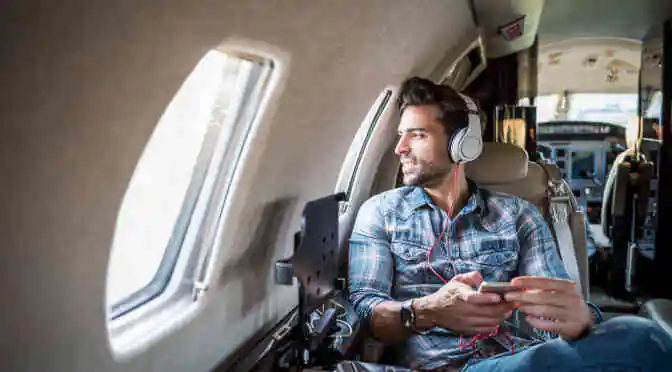Gone are the days when the only form of entertainment for passengers in flight was talking to a fellow passenger, looking out the window or reading books. As air travel became increasingly popular, the airline industry recognized the importance of improving passengers’ experiences in an increasingly competitive sector, and in-flight entertainment (IFE) is at the center of this strategy. IFE has become one of the most significant selection criteria for passengers while booking travel on a particular airline.
Connectivity is central to IFE’s evolution
Over the last few decades, in-flight entertainment systems have seen significant developments, from their initial function as a screen to display an in-flight movie to the device that offers live route views of the flight and a wide range of video and audio entertainment options.. In-flight entertainment systems have improved greatly in recent years, with increased connectivity and the emergence of groundbreaking technologies.
With connectivity being a significant part of the interaction with any electronic device, the IFE system has successfully advanced to become an In-Flight Entertainment & Connectivity (IFEC) system. Driven by the constant demand to improve the passenger experience, the IFEC landscape is witnessing tremendous innovations and advancements. The smart device paradigm is rapidly being adopted, and consumer electronics are making inroads into what was once a protected ecosystem, powered by trends of in-flight broadband and commoditization of hardware.
The IFE industry is undergoing a transformative revolution
The in-flight entertainment industry is experiencing an exciting time of transformation, with systems becoming more and more advanced and innovative. With the advancement in air travel technology, modern long-haul airplanes have reduced the need for stop-overs and have consequently increased flight durations. This has undoubtedly strengthened the inflight entertainment industry, and the growing passenger demand has given rise to emerging IFE solutions. There are several different ways that IFE systems are moving forward, which include wireless, BYOD, embedded, immersive, or a blend of all four.
Personalization and wireless tech are in massive demand
Wireless technologies, mainly Wi-Fi, have recently found widespread acceptance for internet services within the aircraft cabin for passengers. According to recent research, wireless in-flight entertainment is projected to reach a global count of almost 9000 aircraft by 2021. This technology can be further used for the IFE system in place of the wired network, either embedded or handheld. Using wireless has some remarkable benefits for the airline. which include simpler installation and maintenance, weight reduction due to the elimination of cabling, and reductionin fuel costs.
While many low budget airlines still use fixed IFE screens, the trend is rapidly shifting, as most passengers today prefer their own devices for in-flight entertainment. Aircraft are jumping on the BYOD (Bring Your Own Device) trend and replacing their existing in-flight entertainment systems by turning passenger PEDs into the most comprehensive solution. With BYOD gaining massive popularity, personalization is the new king of the IFE industry.
2018 will see the development of Inflight VR
Virtual Reality (VR) is being heralded as the next generation technology for in-flight entertainment systems. Many aircraft companies are investing heavily in the technology to differentiate themselves from competitors. The race to be the first to implement VR technology in aircraft is heating up, with companies such as Inflight VR leading the way.
The technology has already been tested by Australian airline Qantas, which provided VR headsets to its passengers on selected routes. New movies along with Qantas products were shown to passengers. Airlines are striving to provide an entirely new experience to passengers through virtual reality, and this is happening now.
Overall, the in-flight entertainment market is set to take flight in 2018, with recent advances in technology that align with the growing demand for a gratifying passenger experience. The success of an airline indeed relies on the quality of the experience they offer to passengers, and IFEC systems will play a pivotal role in this success.



